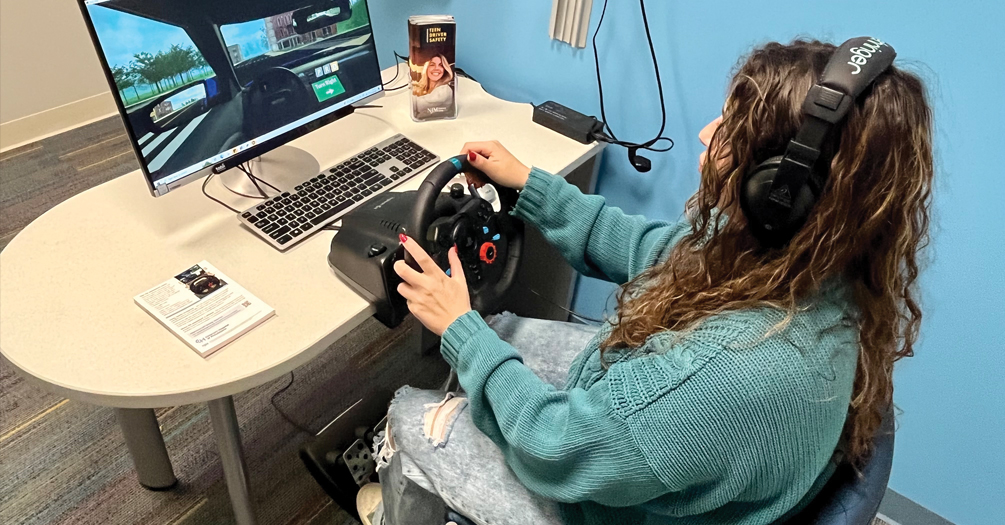A biostatistics breakthrough: Using data to improve teen driving

By Jenni Laidman
In Michael Elliott’s line of work, numbers save lives. Elliott, professor of Biostatistics at the University of Michigan School of Public Health, is an expert in the art and science of collecting, interpreting and analyzing data. His specialty, biostatistics, solves problems in public health, medicine and science, sifting through sand piles of data to unearth the gold nuggets of meaning.
One of his most recent projects could help save lives of a particularly accident-prone population: young drivers.
It’s part of a two-decade-long, traffic-safety-research collaboration with a team from the University of Pennsylvania, led by Dr. Flaura K. Winston, a pediatrician and an engineer. Winston, the Distinguished Chair of Pediatrics at Children’s Hospital of Philadelphia and professor of Pediatrics at the University of Pennsylvania, was the first to uncover that children were dying from front-seat airbags.
Elliott began working with Winston while an assistant professor at Penn from 2000 to 2005, focusing first on children in motor vehicle accidents. At the time, Elliott’s two daughters were preschoolers, adding special significance to the undertaking. One early study led the auto industry to reexamine pickup truck design when it found that children in the rear seats of extended-cab pickups were at an almost five times greater risk of injury than those in the rear seats of other vehicles.
“Mike was with us almost from the beginning,” Winston said. “His contributions were critical at every phase of our work because he’s an expert in so many things. He co-designed sampling and surveys and oversaw our statistical analysis. The quality of our work and its impact is because of Mike’s expertise and contributions.”

Targeting teen driving safety
As the collaboration turned to the urgent need for teen driving safety, Elliott’s two daughters were in their teenage years. “So, there was a personal connection for me,” he said, as there was for so many parents.
In 2021, 2,116 drivers ages 15-20 died in motor vehicle accidents, according to the most recent data from the National Highway Traffic Safety Administration. And deaths aren’t all of it: More than 203,000 teen drivers were injured in 2021, creating $40.7 billion in medical costs, the Insurance Institute for Highway Safety reported.
It’s a problem out of proportion to the size of the teen driving population. Although teens account for just 5% of licensed drivers, they’re responsible for 8.4% of fatal crashes and 12% of all police-reported crashes. Automobile accidents are the No. 1 cause of death for teen girls, and even though teen boys die in far greater numbers—1,866 boys died in 2020 compared to 864 girls—motor vehicle accidents are the No. 3 cause of death for boys, behind homicide and suicide.
In the months it takes new drivers to develop the judgment and skill of experienced drivers, they’re at their most vulnerable.
“Crash risk goes exponentially higher from the day before you get your license to the day you get it,” said Liz Walshe, a research scientist at the Center for Injury Research and Prevention, Children’s Hospital of Philadelphia, who co-leads the Neuroscience of Driving research program. “Teens start driving independently and traveling new routes with no supervision.”
And that’s what the team’s intervention targets, Elliott said, with savvier training.
“There’s no reason you couldn’t train people to drive the way we train pilots,” he said.
Identifying risky teen drivers
A driving simulator developed by Diagnostic Driving Inc., a spin-off from Children’s Hospital of Philadelphia research—Winston is a co-founder—offers the hair-raising experiences no mom supervising her son’s road practice wants to be part of and no driver’s examiner would risk.
Using a computer monitor, a steering wheel and brake and gas pedals, the assessment system records how drivers respond when pedestrians run into traffic, the car in front brakes suddenly, and other dicey moments behind the wheel.
But creating a program laden with high-risk scenarios wasn’t enough. Researchers had to figure out which behaviors contributed to bad outcomes. That was Elliott’s job.
“I was trying to figure out, first of all, what are the pieces that are important?” he said. “We had an enormous amount of data from these trial driving situations. How do we summarize it to pull as much information out of that data as possible, fashioned in a way that’s useful from a scientific perspective?”
What emerged from his efforts was a list of 20 driving behaviors featuring things like jerky braking, throttle control, jackrabbit starts, tailgating, aggression, recklessness, rule-breaking and steering control.
The team took the list of 20 behaviors and organized them into four risk clusters. From best performance to worst, the categories were:
- “No Issues” for cautious drivers with good steering control and good braking
- “Minor Issues” for those with generally good control but minor problems with jerky breaking, tailgating, speeding
- “Major Issues” for skilled rule-breakers or those extremely slow and with poor control
- “Major Issues with Dangerous Behaviors” encompassed drivers with poor control and reckless, rule-breaking behavior
The research team proved the accuracy of these categories when the state of Ohio gave the virtual driving test as part of its licensure process—although the virtual driving test results did not change whether the teen received a license. In more than 33,000 driver assessments, the researchers found that drivers in both “Major Issues” categories were most likely to fail their on-road test. Those in the first two categories were least likely to fail the exams. The research was published in 2022 in Transportation Research Part F: Traffic Psychology and Behaviour.

Predicting teen crashes
Test results are one thing; real-world performance could prove entirely different. The team’s next study tackled that question, tracking the accident records of nearly 17,000 drivers ages 16-24 who took the virtual driving assessment at licensure.
Again, the driving assessment proved to be a powerful tool. In an October paper in the journal Pediatrics, Elliott and the team revealed that teens rated as having “No Issues” had a 10% lower risk of an accident than the average young driver. At the other end of the spectrum, teens rated “Major Issues with Dangerous Behaviors” had an 11% higher risk of an accident than the average young driver.
Mike was with us almost from the beginning. His contributions were critical at every phase of our work because he’s an expert in so many things. He co-designed sampling and surveys and oversaw our statistical analysis. The quality of our work and its impact is because of Mike’s expertise and contributions.”
— Dr. Flaura K. Winston on Michael Elliott
Several questions remain, however, including how much actual driving did the young drivers do? Were some drivers more accident-prone simply because they were on the road more often, increasing the probability of a mistake?
To address this and other questions, the team will follow 1,000 young Pennsylvania drivers who will take their first virtual driving assessment as a learner-driver and receive feedback about what they need to improve. A second assessment with feedback will take place when they go in to take a driver’s exam.
The 1,000 study participants will receive an app that keeps track of how much driving they do and how well they do it. Finally, each will be randomly assigned to participate in one of three groups: One-third will receive behind-the-wheel driver’s training, the kind of course that’s routine in some states, but not in Pennsylvania; one-third will receive a state-of-the-art online driver’s training module; and one third—the control group—will receive no training. The issue of training is particularly important for older teens in many states, including, for instance, Ohio and Michigan, which require driver’s ed for teenagers, but not for those 18 or older.
The Pediatrics paper showed that 18-year-olds are at grave risk. They were 16% more likely to crash than younger drivers.
“The 16-year-olds are actually the best drivers,” Walshe, lead author on the paper, said. One reason could be that the 18-year-olds never had to take driver training.
For Elliott, the work with the Children’s Hospital/Penn team has done more than give him interesting problems to solve and the funding to do it.
“These collaborations are important to my own methodological work at Michigan Public Health,” he said of the kind of research papers that other biostatisticians read to sharpen their own statistical methods.
And it led to work that has saved lives.
